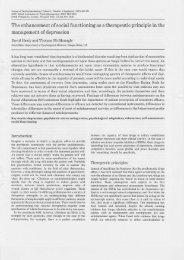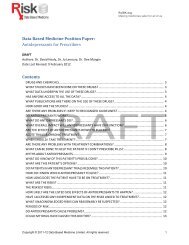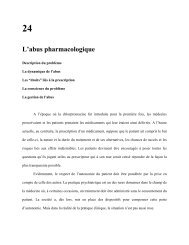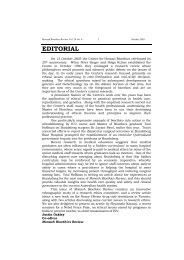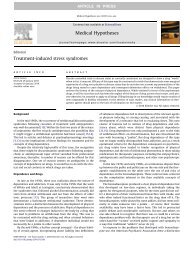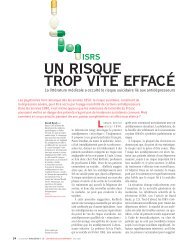DBM Paper - Halting Antidepressants - Dr. David Healy
DBM Paper - Halting Antidepressants - Dr. David Healy
DBM Paper - Halting Antidepressants - Dr. David Healy
Create successful ePaper yourself
Turn your PDF publications into a flip-book with our unique Google optimized e-Paper software.
RxISK.orgSearch. Report. Contribute.info@RxISK.org<strong>Halting</strong> <strong>Antidepressants</strong> Dependence on and withdrawal from imipramine, the first tricyclic antidepressant was reported in 1959. It had only been introduced in 1958. It now seems highly likely that the effects on stopping imipramine stemmed from its serotonin reuptake inhibiting ability. It also acts on the cholinergic system and for some years the withdrawal effects were put down to cholinergic rebound. While cholinergic rebound perhaps can happen the main problem likely stems from the serotonin system. Tricyclics like imipramine also act on the norepinephrine system. At the moment it is not clear what these effects might contribute on stopping. Potent SSRIs SSRI stands for selective serotonin reuptake inhibitor. This does not mean these drugs are selective to the serotonin system or that they are in some sense pharmacologically “clean”. It means they have little effects on the norepinephrine/noradrenaline system. There are 8 potent serotonin reuptake inhibitors on the market: UK Trade Name Fluoxetine Prozac Prozac Paroxetine Seroxat Paxil Sertraline Lustral Zoloft Citalopram Cipramil Celexa US Trade Name Escitalopram Cipralex Lexapro Fluvoxamine Faverin Luvox Venlafaxine Effexor Efexor Duloxetine Cymbalta Cymbalta These drugs in the doses they are usually given are grossly overpowered. It’s like a huge articulated truck traveling down a stone-‐walled country lane. Less potent SSRIs Clomipramine Anafranil Anafranil Imipramine Tofranil Tofranil Amitrityline Elavil Tryptizol Dosulepin Prothiaden Copyright © 2012 Data Based Medicine Americas Ltd. Page 2 of 13
RxISK.orgSearch. Report. Contribute.info@RxISK.org• Change of personality • An intolerance to stress Other effects See <strong>DBM</strong> <strong>Paper</strong> – Medicine Induced Stress Syndromes. Rebound effects <strong>Antidepressants</strong> may be linked to a number of rebound effects such as increased clotting Stress effects Withdrawal can give rise to tardive dyskinesia, tardive dysthymia and other tardive syndromes – see below Legacy effects Antidepressant may cause persistent sexual dysfunction and other persistent problems including in some people an increased likelihood of relapse. Catastrophic effects There are a small number of people who have a severe syndrome with neurological and other features that may start within weeks of starting an antidepressant and even if only exposed to these drugs for a few weeks, the after-‐effects may endure for months or years. All difficulties outlined above may wax and wane and this can be demoralizing. Is this withdrawal? There are three ways to distinguish antidepressant withdrawal from a nervous problem that might have to treatment with an antidepressant in the first instance – many people put on these drugs do not have a significant mood disorder. 1. If the problem begins immediately on reducing or halting a dose or begins within hours or days or perhaps even weeks of so doing then it is more likely to be a withdrawal problem. If the original illness or difficulties have cleared up and you are doing well, then on discontinuing treatment no new problems should show up for several months or indeed years. 2. If the nervousness or other odd feelings that appear on reducing or halting the SSRI (sometimes after just missing a single dose) clear up quickly when you are put back on the SSRI or the dose is put back up, then this also points towards a withdrawal problem rather than a return of the original illness. When original illnesses return, they take a Copyright © 2012 Data Based Medicine Americas Ltd. Page 4 of 13
RxISK.orgSearch. Report. Contribute.info@RxISK.orglong time to respond to treatment. The relatively immediate response of symptoms on discontinuation to the reinstitution of treatment points towards a withdrawal problem. 3. While the features of withdrawal may overlap with features of the nervous problem for which you were first treated -‐ both may contain elements of anxiety and of depression, withdrawal will also often contain new features not in the original state such as pins and needles, tingling sensations, electric shock sensations, pain and a general flu-‐like feeling. Before starting to withdraw, it should be noted that many people will have no problems on withdrawing. Some will have minimal problems, which may peak after a few days before diminishing. Symptoms can remain for some weeks or months. Others will have greater problems, which can be helped by the management plan outlined below. Finally however there will be a group of people who are simply unable to stop whatever approach they take. Some others will be able to stop but will find problems persisting for months or years afterwards. It is important to recognise this latter possibility in order to avoid punishing yourself. Specialist help may make a difference for some people in these two groups, if only to provide possible antidotes to attenuate the problems of ongoing SSRIs such as loss of libido. How to withdraw If there are any hints of problems on withdrawal from SSRIs, you may wish to show this to your doctor. Over-‐rapid withdrawal may be medically hazardous, particularly in older persons. Many doctors suggest you withdraw by taking one pill every other day for a few weeks before stopping. There is no guideline that advocates this or evidence that supports it and except for fluoxetine which has a very long half-‐life the approach is misguided. It can make things worse. One of the first steps to consider is getting a liquid formulation of your antidepressant. This can be done by asking your doctor to approach the local primary care pharmacist who can make an application to one of the specialist companies that can make up a liquid formulation of almost any antidepressant you might be on – see below. There are 2 theories about what leads to dependence and withdrawal that dictate slightly differing management plans. One theory is that the relatively short half life of paroxetine and venlafaxine make these two drugs more problematic. This leads to a withdrawal strategy that advocates switching from paroxetine or other drugs to fluoxetine. Copyright © 2012 Data Based Medicine Americas Ltd. Page 5 of 13
RxISK.orgSearch. Report. Contribute.info@RxISK.orgb) Yet another option is to change from paroxetine or whatever the original drug was to a mixture of half the previous dose of the original drug and the other half in the form of fluoxetine. The next step is to reduce gradually the dose of the original drug and after that to reduce the fluoxetine. Next steps a) Stabilise on one of these options for up to 4 weeks or more before proceeding. b) For uncomplicated withdrawal, it may be possible to then drop the dose by a quarter of the original. c) If there has been no problem with step 3, a few weeks later, the dose can be reduced to half of the original. Alternatively if there has been a problem with the original drop, the dose should be reduced by 1 mg amounts in weekly or two weekly decrements. d) From a dose of fluoxetine 10mgs liquid or tablets or imipramine 10mg tablets or liquid, consider reducing by 1mg every week over the course of several weeks -‐ or months if need be. (a syringe is helpful in reducing the dose evenly). e) If there are difficulties at any particular stage the answer is to wait at that stage for a longer period of time before reducing further. If there are difficulties, monitoring by a doctor, pharmacist or nurse with some experience of managing withdrawal is needed. Pregnancy The single most important group who need to be aware of all these issues are women of child-‐bearing years. A very large number of pregnancies happen in an unplanned fashion and are several weeks advanced before the woman is aware of the situation. SSRIs are now clearly linked to a number of problems in pregnancy, among which are an increased frequency of birth defects, an increased rate of miscarriage, premature birth, low birth weight, a neonatal withdrawal syndrome and pulmonary hypertension in the newborn infant. They may also be linked to autistic spectrum disorder, learning disabilities or mental handicap in children born to mothers who have been taking them through pregnancy. One of the biggest problems of SSRI dependence involves women who are on treatment and unable to stop who wish to become pregnant. Getting off an SSRI at present seems more difficult for women than men, even with the incentive of wishing to become pregnant. Copyright © 2012 Data Based Medicine Americas Ltd. Page 7 of 13
RxISK.orgSearch. Report. Contribute.info@RxISK.orgOther treatments There are some hints that triptans, such as sumatriptan, may alleviate some withdrawal problems. The alleviation occurs while the drug is in the system. As such it is not a treatment of withdrawal but in offering a temporary respite may make it easier for some people to go on. Liquids In the UK Rosemont Pharmaceuticals (Tel 0113 244 1999) Cardinal Health, Martindale (Tel 0800 137 627) Large chain pharmacies like Boots. In the US Please help us by sending us details. In Canada Please help us by sending us details. Elsewhere Please help us by sending us details. Tardive dysthymia Background It is now generally accepted that antidepressants can cause physical dependence and a significant withdrawal syndrome that may be severe. While these problems are often over in weeks, they may last for months. Pharmaceutical companies and regulators have avoided terms like dependence and withdrawal, but their avoidance is no protection for the rest of us. It has been known since the 1960s when dependence on and withdrawal from antipsychotics was first outlined that in addition to classic states such as tardive dyskinesia that might be revealed by withdrawal, a variety of stress syndromes that have since been termed tardive dysthymia, tardive akathisia and other tardive syndromes might also emerge. By the time enduring problems emerge after antidepressant discontinuation, the character of the initial problem has commonly changed. The initial problems of withdrawal often centre on electric zaps”, and “electric head”, but later these recede into the background and Copyright © 2012 Data Based Medicine Americas Ltd. Page 9 of 13
RxISK.orgSearch. Report. Contribute.info@RxISK.orgare replaced by a restless or dysphoric state consistent with a tardive dysthymia or tardive akathisia. It should be noted that in addition to the abnormalities of sensation common in the initial phases, many of those affected complain of anxiety and depressive symptoms also. As time goes by these depressive states may come to the fore and may seem like new illnesses, or they may seem even harder to distinguish from an original depression than the initial withdrawal state was. Enduring states of this type can follow discontinuation from all antidepressants active on the serotonin system. The problem has not been as apparent on other antidepressants but this may reflect frequency of usage of SSRIs rather than anything else. The problems appear more common in women than in men but this again may reflect frequency of usage. The characteristic symptoms include “depressive symptoms”, agitation, depersonalization, akathisia, a generally labile state and stress intolerance. Enduring problems can follow either abrupt or tapered discontinuation of treatment. One difficulty lies in knowing how common such states are. A great number of individuals presenting to their doctors with these disorders are in all likelihood being told they have a recurrent affective disorder and are put back on an antidepressant. This will happen for three reasons. First the problems will often look “depressive”. Second, most physicians simply do not think that neurological problems of this sort could persist this long. Third, the picture may seem different to the original problems on withdrawal. This interpretation is made more likely by the fact that most people will have had slightly better periods before a bad period leads them to seek help. But even tardive dyskinesia goes through good and bad phases. Managing tardive dysthymia The management of tardive dysthymia is different to managing severe withdrawal. At present it is not clear what helps the difficulties some people seem faced with 6 months or more into the discontinuation period. Faced with ongoing problems, people commonly ask whether they should go back on the original antidepressant and start a new and even more gradual taper. This seems problematic for two reasons. First going back on something that has caused such difficulties, perhaps through some vulnerability of the taker’s serotonergic or a related system, seems risky. Copyright © 2012 Data Based Medicine Americas Ltd. Page 10 of 13
RxISK.orgSearch. Report. Contribute.info@RxISK.orgSecond some of those who have gone back on treatment have needed to go back on a higher dose than previously in order to alleviate problems and in some instances a return to the original medication has not alleviated the problem. Generally the longer the interval off the drug, the less likely it has been that reinstituting the treatment will lead to a resolution of the symptoms. If an individual does return successfully to treatment, the question is what next. Based on experience with the management of withdrawal from antipsychotics, one option might be to remain on treatment indefinitely. There are several drawbacks to this. In the case of the antidepressants it is not at present known if ongoing treatment increases the risk of premature mortality or other disorder. The risks of fractures or haemorrhages are increased, and substantially increased if combined with other treatments like aspirin. If the taker has found the SSRI helpful but also emotionally blunting, this would be a significant impairment to quality of life. A second option is to turn to an antihistamine, such as chlorpheniramine, or to a tricyclic antidepressant, such as dosulepin or imipramine, or to St John’s Wort. The rationale here is that a small amount of serotonin reuptake inhibition may be all that is needed to produce a helpful anxiolytic effect in those suited to drugs of this type. SSRIs are in fact almost grotesquely overpowered for the purpose as outlined above. A third option is to turn to a completely different therapeutic principle. Among the options are drugs active on the cholinergic system, calcium channel blockers or dopamine agonists. Choline-‐esterase inhibitors may help tardive dysthymic states, in that they have been reported to offer a benefit in tardive dyskinesia, and have been helpful in some cases of SSRI withdrawal. Calcium channel blockers have been reported to benefit some individuals with enduring problems after antipsychotic withdrawal. Dopamine agonists or stimulants are used in restless legs and related syndromes, and restlessness is often a component of the problems facing individuals after stopping antidepressants. The final point concerns the likely duration of a tardive dysthymic episode. Based on the precedent of tardive dyskinesia, it seems such states may last for years. In older individuals they may last indefinitely. In younger individuals, they are more likely to clear up in a 12-‐36 month timeframe. The resolution of difficulties may require something like a synthesis of new receptors to replace receptors that have been jettisoned in the face of the physiological stressor of the Copyright © 2012 Data Based Medicine Americas Ltd. Page 11 of 13
RxISK.orgSearch. Report. Contribute.info@RxISK.orgSSRI. Whatever the mechanism recovery does happen but may take years and seems likely to be facilitated by activity of various sorts and most probably by an avoidance of psychotropic medication – including antihistamines and other compounds. It is particularly important for patients suffering from this condition to have a name for the state and an explanation for what is happening. It is not clear at the moment how great the overlap might be between the tardive dysthymia linked to antidepressant, antipsychotic or benzodiazepine withdrawals. The risks of having an enduring problem appear slightly greater for women, and may increase with age. There is no clear understanding of what happens in the brain to trigger such problems but it may be that with extended exposure to an antidepressant, some sensitive individuals lose receptors from the ends of their nerve terminals as part of an adaptive mechanism and when the drug is removed these receptors do not simply return to normal. If the explanation offered above is even partly correct, it implies that with time the condition should resolve but this resolution may take months or years. It would seem intuitively sensible to suggest that activity, which helps to refashion nerve endings, would help and those affected should therefore be encouraged to be physically active and in general to live life as fully as possible and avoid shutting down or withdrawing from activities. Activities such as walking or swimming may be helpful especially if undertaken in a graded programme that ensures there is daily activity and over time builds the activity levels up. Managing new affective episodes Another issue that needs to be addressed is the emergence of a new affective episode rather than a flare-‐up of tardive dysthymia. In this case, it seems likely that if someone got well on a serotonergic agent in the first instance, they are more likely to show a better initial response to another SSRI than they are to respond to an agent from a different class. This raises the question of whether the short term benefit is worth taking given the likely longer term problems. To some extent this issue depends on what the alternatives are. First if this is truly is a depressive disorder that has responded to an SSRI in the first instance, this means it is not a particularly severe mood disorder and as such the need to bring about a quick response with drugs because of risks like suicide is not high. It would seem best however to take a drug that has less potent serotonin reuptake inhibiting properties – such as imipramine. Second, not intervening pharmacologically is often a reasonable option for two reasons. One is that the natural history of such disorders is that they will resolve on average within Copyright © 2012 Data Based Medicine Americas Ltd. Page 12 of 13
RxISK.orgSearch. Report. Contribute.info@RxISK.org12 to 16 weeks. Another is that there is considerable evidence to suggest that those who respond without pharmacological or other interventions are less likely to relapse in future. Third, related to not-‐intervening there are a number of things affected individuals can do for themselves. Exercising, particularly in a routine, is likely to be helpful, as is physical work generally. Diet, especially avoiding alcohol, is likely to be of some importance. There are other more esoteric steps a person can take. One is sleep deprivation, which is undertaken regularly as an antidepressant treatment in many European countries. Finally, CBT or other psychotherapeutic procedures may be of benefit, where these would seem to be less likely to be helpful in tardive dysthymic states. Copyright © 2012 Data Based Medicine Americas Ltd. Page 13 of 13



